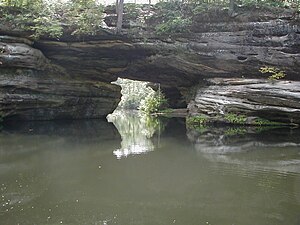| Pickett Civilian Conservation Corps Memorial State Park | |
|---|---|
| Pickett State Park | |
 Arch Lake in Pickett State Park | |
| Type | Tennessee State Park |
| Location | Pickett County, near Jamestown, Tennessee |
| Coordinates | 36°33′06″N 84°47′49″W / 36.55157°N 84.79703°W |
| Area | 19,200 acres (78 km2) |
| Operated by | Tennessee Department of Environment and Conservation |
| Open | open year round |
| Website | Pickett CCC Memorial State Park |
Pickett State Rustic Park Historic District | |
| Built | 1934-1942 |
| Built by | Civilian Conservation Corps |
| Architect | Works Project Administration, National Park Service |
| NRHP reference No. | 86002795 |
| Added to NRHP | 1986 |
Pickett Civilian Conservation Corps Memorial State Park (also known simply as Pickett State Park or Pickett CCC Memorial State Park) is a Tennessee state park in the upper Cumberland Mountains. It is located in Pickett County, northeast of the city of Jamestown, and is adjacent to the Big South Fork National River and Recreation Area. The park is located on 19,200 acres (78 km2) of wilderness including caves, natural bridges, and other rock formations.[1] About 1,000 acres (4.0 km2) are managed by the Tennessee Department of Environment and Conservation as a state park, and the remainder of the property is managed by the Tennessee Division of Forestry as a state forest.[2][3]
The park was developed by the Civilian Conservation Corps (CCC) between 1934 and 1942 on about 12,000 acres (49 km2) of land donated to the State of Tennessee in 1933 by the Stearns Coal and Lumber Company. CCC crews built hiking trails, a recreation lodge, a ranger station, five rustic cabins, and a 12-acre (4.9 ha) lake known as Arch Lake. Locally quarried sandstone was used in constructing most of the buildings. The original park facilities are listed on the National Register of Historic Places.[1] Pickett's land area has increased over time as a result of additional land donations and acquisitions,[4][5] and additional park facilities were built beginning in the 1950s.[2]
In 2015, Pickett State Park was classed as a Dark Sky Park by the International Dark-sky Association. These are areas generally free of artificial light pollution, making them optimal places for stargazing.[6]
The park offers boating, camping, lodging, hiking and many other activities.[1]
- ^ a b c Pickett State Park, Tennessee Department of Environment and Conservation website, accessed November 13, 2009
- ^ a b Pickett State Rustic Park, Tennessee Encyclopedia of History and Culture
- ^ Pickett State Forest, Tennessee Department of Agriculture website, accessed November 13, 2009
- ^ Morgan Simmons, Pickett Forest Gets 1,541-acre Addition, Knoxville News Sentinel, December 22, 2003, archived on Congressman Lincoln Davis' website
- ^ Milestones of the Tennessee Chapter of The Nature Conservancy, accessed November 13, 2009
- ^ "Pickett CCC Memorial State Park & Pogue Creek Canyon State Natural Area (U.S.)". darksky.org. Retrieved April 11, 2017.
